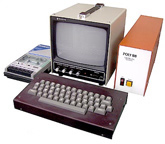|
The Poly-88
 The Poly-88 was the first complete computer from PolyMorphic Systems. It was housed in a five-slot S-100 chassis, with additional (optional) side-mounted connectors for the purpose of joining chassis together. This unit earned the nickname "orange toaster" due to its orange metal cover, and the fact that the S-100 cards generated noticeable heat. The Poly-88 was the first complete computer from PolyMorphic Systems. It was housed in a five-slot S-100 chassis, with additional (optional) side-mounted connectors for the purpose of joining chassis together. This unit earned the nickname "orange toaster" due to its orange metal cover, and the fact that the S-100 cards generated noticeable heat.
The Poly-88 was available in kit form, or assembled. The keyboard and monitor were sold separately, and you provided your own cassette recorder for program storage.
Software
The Poly-88 CPU card contained a single 1,024-byte ROM, with a boot loader program called the "Famous 4.0 Monitor." The Monitor contained drivers for the screen, keyboard, and cassette tape loader. A listing of the Monitor program was provided in the manual, which was a great learning tool for the novice programmer.
Programs could be stored on tape in two different formats. BYTE standard (a.k.a. Kansas City standard) tapes were interchangeable with other systems. Polyphase tapes could only be read by another Poly-88, and required a higher-fidelity cassette player, but they loaded substantially faster. The data rates were 300 and 2400 bps, respectively.
When you cold-booted a Poly-88, you'd be greeted with a blank screen except for a non-blinking, block cursor. Pressing B or P would tell the system to start loading a tape (B for BYTE standard, P for Polyphase). Then, you'd press "play" on your cassette player, and hope for the best. Tapes didn't always load reliably.
Front Panel
Pressing Control-Z would take the system into a software front panel mode. Unlike the IMSAI and Altair, the Poly didn't have lights and switches on its front panel, so the '88 emulated this feature in software. Users could examine registers, single-step through programs, and even load small programs into memory using the software front panel.
The illustration to the right is from a magazine ad, and shows an early version of the Front Panel's layout.
You can read more about the Front Panel on this page.
|
 |
The ROM also contained simple input/output routines which could be accessed by other programs. These were functionally equivalent to BIOS routines in CP/M systems, or system calls in Windows or Unix systems. PolyMorphic documentation referred to the entry points for these routines as "wormholes."
If ROMs were installed in the second and third ROM sockets on the CPU board, the program in those ROMs would be executed prior to running the cassette loader. This paved the way for the System 8813, which needed additional code to boot from floppy disk drives.
A BASIC interpreter was available and could be loaded from cassette tape. It required 11K bytes of RAM, meaning it could be loaded in a system containing a 16K RAM card. A version of "Tiny Basic" was also available in ROM form, fitting into the two 1K ROM sockets mentioned above.
Documentation
Poly-88 Assembly and Test Manual
Poly-88 Operation Manual
Poly-88 Cassette Interface
Illustrations
|
|